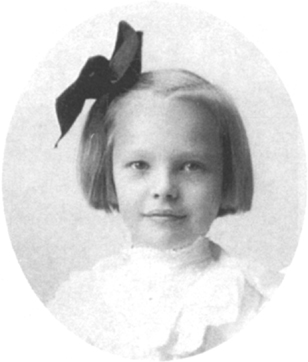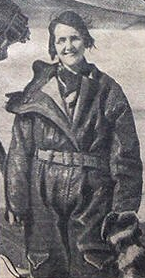A Women's Air Derby was launched that year in conjunction with the Cleveland Air Races. The rules were straightforward: whoever got to Cleveland in the least time won! The entries were divided into two classes, depending upon size of engine. The starting point was Santa Monica, flying across the continent to Cleveland. The most famous names of the day were in the lineup, with Will Rogers on hand at the takeoff. He remarked that the start looked like a "powder puff derby." Louise Thaden claimed first in the faster aircraft division with her Travel Air J-5 and Phoebe Omlie was first in the second division.
After all had arrived in Cleveland, Amelia Earhart, Gladys O'Donnell, Ruth Nichols, Blanche Noyes, Phoebe Omlie and Louise Thaden gathered under the grandstand and, at the suggestion of Phoebe Omlie, considered forming some kind of organization just for women pilots. They sent out an organizational letter to all of the licensed women pilots in the United States. On Nov. 2, 1929, 26 women met and chartered an international organization of women pilots known as the Ninety-Nines.
Other female pilot groups sprang up also. Five of the '29 Air Derby participants met at the home of Gladys O'Donnell in Long Beach and formed the Skylarks. Opal Kunz, disappointed that the 99s had not gone in the direction of her desire for a tightly-disciplined group dedicated to national defense, formed the Betsy Ross Corps in 1931. The objective was to be of service to the country through humanitarian relief work. Later, at the outbreak of WWII, Opal Kunz once again formed a women's defense program, this time called the Women Fliers of America. The group was devoted to training women pilots to replace men going off to war.
An offshoot of the Betsy Ross Corps came through Florence "Pancho" Barnes, who envisioned an unofficial division of the US Amy Air Corps. The Women's Air Reserve evolved under Pancho's strong leadership and was quite successful. The Reserve served in several disasters including the Montrose Flood. They were undoubtedly ahead of their time, and aspects of their service later could be seen in the WASPs and the Civil Air Patrol.
Louise Thaden quickly achieved an altitude record, an endurance record and a speed record in a Beech Travel Air. In 1936 the all-male Bendix Trophy Race was opened to women. Louise, along with Blanche Noyes, flew to first place in a Staggerwing Beech. That year Louise Thaden was awarded the Harmon Trophy as the world's outstanding flyer.
Lady Mary Heath fought the bureaucratic battle in Britain for women who followed. She had passed her "A" license without difficulty, but when it came to the "B," permitting the carriage of passengers, the English Air Ministry was skeptical about entrusting passengers' lives to a woman. Finally, a committee studied the question of physical tests for women pilots, and the athletic Lady Heath accomplished the breakthrough.
American socialite Ruth Nichols became a flying addict, flying dirigibles, gliders, auto gyros, seaplanes, amphibians and four-engine aircraft. She held three different world records at one time and an early transport license. Not content with transcontinental record flights, Ruth aspired, along with Laura Ingalls and Amelia Earhart, to solo the Atlantic.

As thoughts of war couldn't be avoided, Ruth became convinced that airplanes could play a prominent role as air ambulances. Ruth founded Relief Wings, whose purpose was a humanitarian air service in case of either civilian disasters or war.
After the outbreak of WWII, Ruth turned the basic structure over to the Civil Air Patrol.On Dec. 27, 1938, President Roosevelt authorized the CAA to train 20,000 private pilots a year in the nation's colleges. The program was called the Civilian Pilot Training program, and its purpose was twofold: to stimulate aviation's growth and to build up a reserve of pilots to which the military might turn. The CPT program was a huge success, and many women pilots learned to fly under the auspices of CPT, or taught in the program.
(3) Amelia Earhart as a child.
(4) Ruth Nicols (New York Evening Graphic front page, Feb 15, 1932)
More Articles
- National Archives Records Lay Foundation for Killers of the Flower Moon: The Osage Murders and the Birth of the FBI
- Nichola D. Gutgold - The Most Private Roosevelt Makes a Significant Public Contribution: Ethel Carow Roosevelt Derby
- Oppenheimer: July 28 UC Berkeley Panel Discussion Focuses On The Man Behind The Movie
- "Henry Ford Innovation Nation", a Favorite Television Show
- Women at War 1939 - 1945, The Imperial War Museums: Queen Elizabeth
- Julia Sneden Wrote: Going Forth On the Fourth After Strict Blackout Conditions and Requisitioned Gunpowder Had Been the Law
- Jo Freeman Reviews: Gendered Citizenship: The Original Conflict Over the Equal Rights Amendment, 1920 – 1963
- Jo Freeman Writes: It’s About Time
- Jo Freeman Reviews: Lady Bird Johnson: Hiding in Plain Sight
- Women in Congress: Biographical Profiles of Former Female Members of Congress






